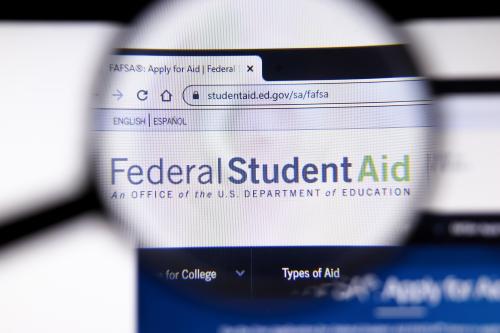Seemingly race-neutral policies sometimes generate and perpetuate racial inequities. In her recent book, Dorothy Brown documents that the U.S. income tax system is one such example. Among other provisions, she shows that the favorable tax treatment of home ownership and retirement savings provide greater advantages to white families than Black families.
We argue that similar problems plague the college financial aid system, generating racial disparities in college affordability [1]. As in the tax system, the treatment of home ownership and retirement savings in financial aid determination contribute to perpetuating racial disparities in college access.
Racial disparities creep into the system because the federal formula for estimating how much a family can afford to pay for college ignores a family’s home equity in their primary residence and the value of their retirement savings. Families that own more of these “uncounted” assets have greater financial resources than families that do not. Yet at similar income levels and other asset holdings, families that own their home or have retirement savings are given the same level of financial support for college as those without. We show below that white families are far more likely to own these uncounted assets and at higher levels, which generates racial disparities in college affordability.
We must emphasize this is not a factor that affects all students. Families with low incomes typically have insufficient assets of any type for this issue to matter, regardless of race. Very high-income families are unaffected because they are unlikely to be eligible for financial aid regardless of the assets they may own. For those with middle to high family incomes, though, ownership of uncounted assets provides an implicit subsidy for college attendance in the form of additional grant-based financial aid from their educational institution, which does not need to be repaid. As we report below, almost one million students are likely to benefit from this subsidy each year.
The racial disparities in college affordability that result from the policy choice of excluding home equity and retirement savings from calculations made by the federal financial aid system are substantial. We calculate that among families whose children are likely to benefit from this provision (middle to high incomes, typical counted assets, and sufficient remaining financial need to qualify for grant-based aid), white students receive an implicit subsidy that is $2,200 per year, on average, more than for Black students. In a recent paper, we provide some evidence suggesting that the resulting difference in college affordability alters students’ educational outcomes, including whether and where they attend college, whether they graduate, and their level of student debt.
Estimating how much a family can “afford” and the racial wealth gap
The underlying idea behind financial aid is straightforward. Students and families with lower incomes and assets cannot afford to pay as much and should receive more financial aid. Families provide information to the federal government and colleges about their incomes and assets for the purpose of estimating how much each family can “afford” to pay [2] The federal government and individual educational institutions use that information to decide how much financial aid to offer students. The formulas and processes used to determine what families can “afford” and how much financial aid they are offered are extremely complicated, and we summarize the key elements here.
Along with detailed information regarding income, the federal form that collects information for calculating financial aid eligibility (the FAFSA form) asks about assets, including funds in bank accounts, the value of investments and real estate, and the value of businesses and farms. It specifically states that applicants should not include home equity from a primary residence or funds in retirement savings accounts such as 401(k) plans and Individual Retirement Accounts (IRAs). Home equity and retirement savings are excluded from financial aid calculations based on the idea that families should not be expected to borrow against their homes or diminish their retirement savings to pay for a child’s college education [3].
Yet the existence of a racial gap in asset ownership is well-known; this gap is present for all types of assets, including the categories that are “uncounted” in financial aid formulas. Home equity and retirement savings account for most asset holdings for all but the highest-income households. Racial disparities in asset holdings are long-standing, arising for a variety of reasons, including structural and institutional factors both historical and contemporaneous.
Figure 1 documents this wealth gap for families with children approaching college age (13 to 17) using data for the 2019 Survey of Consumer Finances (SCF). We classify families according to their family income and race [4]. Many of the families with incomes below $125,000 (the first two sets of bars in the figure) are likely to be eligible for financial aid at most colleges and universities, including four-year public institutions. Families in the $125,000 to $200,000 income category (the last set of bars) are also likely to be eligible for financial aid at four-year private institutions. Families with incomes above $200,000 are unlikely to be eligible for financial aid at most institutions and are omitted from this analysis. In our sample, 40 percent of white families and 71 percent of Black families have family incomes less than $75,000; 23 percent of white families and 19 percent of Black families have family incomes between $75,000 and $125,000; and 17 percent of white families and 7 percent of Black families have family incomes between $125,000 and $200,000.
The data show that families with incomes below $75,000 (roughly the median for these families) have limited assets. Counting home equity and retirement savings would have a minor impact on a calculation of how much these students can afford to pay for college, regardless of their race.

That is not true for families with incomes between $75,000 and $125,000 and between $125,000 and $200,000. In both income categories, median asset holdings are much higher for white families; and most of these assets are not counted by the financial aid system. In the $125,000 to $200,000 income category, the median white family holds $284,000 of uncounted assets compared with $66,800 of counted assets. For Black families in this income category, median uncounted and counted assets amount to $67,700 and $16,400, respectively. For both Black and white families, the ratio of median uncounted assets to counted assets is roughly 4 to 1.
Similar patterns are observed, albeit at lower levels, among those in the $75,000 to $125,000 income category. For them, the ratio of uncounted assets to counted assets is roughly 2.5 to 1 regardless of race. The similarities in these ratios by race suggest that the portfolio choices made by white and Black families are similar at comparable income levels, but white families have much larger total asset holdings.
Counting all assets in the financial aid process would increase the amount a student’s family is expected to contribute to their education, which would translate to less financial aid. The fact that the financial aid system does not count certain assets increases financial aid eligibility and lowers the amount families ultimately have to pay. Affected families will receive more grant-based financial aid (colloquially labeled “scholarships,” which are not required to be repaid) as a result even though the uncounted assets can also be used to help finance a child’s college education.
The decision to exclude home equity and retirement assets from consideration in financial aid formulas means that families that hold those assets receive an implicit subsidy to attend college, in the form of additional grant aid, compared with families with similar capacity to pay for college without those assets. The fact that white families are more likely to own the assets, and own more of them, than Black families means that white students receive larger implicit subsidies than Black students. For them, college is more affordable.
Based on methods we report elsewhere, we estimate the difference between the amount students would have paid if all assets were counted in the financial aid formula and the amount they are expected to pay under the current federal financial aid system. This difference represents the implicit subsidy from ignoring uncounted assets. We calculate this amount for each family in the SCF data used to construct Figure 1.
The fact that white families are more likely to own the assets, and own more of them, than Black families means that white students receive larger implicit subsidies than Black students. For them, college is more affordable.
The results of that exercise are reported in Figure 2, distinguishing students by their race and family income. As one would expect, the implicit subsidy for students from families with incomes below $75,000 is small regardless of race; this is because families in that income range do not have substantial uncounted assets regardless of race.
That is not true for students from families in the next two income categories. For those with family incomes between $75,000 and $125,000, the median implicit subsidy that students from white families receive is $3,400 per year, twice that of students from Black families ($1,650). Among those families with incomes between $125,000 and $200,000, the median implicit subsidy jumps to $9,400 per year, over four times that for Black students ($2,200). In aggregate, these subsidies are even greater for white students because the share of white families in these income ranges is larger than in the population at large.
How Many Students are Affected?
The number of students who benefit from these implicit subsidies associated with holding uncounted assets depends on students’ financial circumstances and the types of institutions they attend [5]. Students whose families have limited home equity or retirement savings do not benefit from any implicit subsidies, by definition. As we just documented, this is the case for most lower-income students. The top of the income distribution is similarly unaffected by this feature of the financial aid formula for the simple reason that families are unlikely to be eligible for financial aid at all. Based on our earlier analysis, as a rough approximation, students between the 50th and 90th percentiles of the family income distribution ($67,500 to $201,000 in 2020) are the group most likely to benefit from the favorable treatment of home equity and retirement savings in financial aid determination.
Aside from their family’s finances, eligibility for financial aid also depends on the cost of attendance (COA; the “sticker price”) at the student’s chosen institution. Whether students attend full-time and live on campus contributes to that cost [6]. The amount of financial aid a student can receive is constrained by their “financial need,” which is the difference between the COA and the amount the student is estimated to be able to afford. A student attending a community college that charges, say, $8,000 per year is not eligible for financial aid if they are expected to contribute $10,000. However, that student would likely receive aid at a four-year residential institution if attending full-time and living on campus because of the higher COA. Many private colleges and universities clearly satisfy these characteristics as do many public universities (state flagship and regional institutions, for instance, where most full-time students attend).
Elsewhere, we have used this information to estimate the number of students who are likely to benefit from the advantageous treatment of home equity and retirement savings. We estimate that about 850,000 students each year are likely to be affected by the preferential treatment of uncounted assets, representing roughly 10 percent of all dependent college students and 27 percent of dependent students who are enrolled full-time and living away from home at a 4-year institution.
We further estimate the aggregate value of the implicit subsidy for those students amounts to $2.3 billion per year. This represents twice the annual budget of the Federal Work-Study program. Of that amount, $1.8 billion (78.9 percent) is awarded to white students and $66 million (2.9 percent) to Black students (students in other race/ethnicity groups receive the remaining amount, including $134 million, or 5.9 percent, to Hispanic students).
The Consequences of Differential College Affordability
The affordability differences related to uncounted assets have the potential to generate racial disparities in students’ decisions about whether and where to enroll, their likelihood of graduation, and their level of student debt. For this analysis, we focus on the COA of the institutions attended by dependent students. Community colleges charge the lowest sticker price and elite private institutions charge the highest. Higher sticker prices are associated with better student outcomes like higher graduation rates (although this correlation may be in part due to differences in the populations served at higher- and lower-sticker-price institutions).
We compare the cost of the institutions that students attend among groups of students in the same income categories we examined earlier. The greater implicit subsidies higher-income white students receive may help them attend more expensive institutions, compared with Black students. For this analysis, we rely on data from the 2015/16 National Postsecondary Student Aid Study (NPSAS). These data are high quality, merging administrative data from the U.S. Department of Education and data from the institutions of higher education that students attend, among other sources. The sample size is large; in these data, we restrict our analysis to the 33,000 dependent students enrolled at a single college or university.
The results of this analysis are displayed in Figure 3. As one would expect, students from higher-income families attend institutions with higher price tags. We also see that racial disparities in the COA are small for students with family incomes below $75,000. This is consistent with the limited extent of uncounted assets that these families hold regardless of race. As family incomes rise, though, the gap between the COA at the institutions white and Black students attend grows. This is consistent with the greater implicit subsidies that white students from families with middle-to-high incomes receive, which makes college more affordable for them relative to Black students.
This pattern is what we would expect if uncounted assets disproportionately made high-COA institutions more affordable for white students relative to Black students, generating disparities in outcomes. We note, though, that it does not fully control for other potential differences that might contribute to these gaps. For example, suppose that racial inequities in K-12 education were larger for higher income families; higher-income white students would have better opportunities in college compared to Black students with similar incomes and attend institutions with higher COA. And, as we show above, white families have more assets of all types compared with Black families with similar incomes. This may have a direct effect on college decisions, regardless of how assets are treated in the financial aid system. In a recently released working paper, we discuss potential alternative explanations for these patterns in more detail and provide additional econometric analysis to determine whether we can rule them out. Ultimately, we believe the evidence is suggestive that the treatment of uncounted assets in the financial aid system makes a causal contribution to the observed racial gaps in college outcomes.
Discussion
Our analysis has shown that ignoring retirement savings and home equity when calculating eligibility for financial aid is regressive with respect to income and further results in racial disparities in college affordability because middle-to-high income white students receive disproportionately more grant-based financial aid compared with Black students with comparable family incomes. The resulting gaps in college affordability may also generate meaningful racial differences in educational decisions and outcomes as well as debt.
What can be done to eliminate the disadvantage that Black students face because their parents are less likely to own uncounted assets? One solution is simply to count those assets, which would increase the cost of college for the holders of those assets. The objective, however, is not to make college more expensive overall, but to redistribute some of those costs to make the system more equitable. That can be accomplished, for example, by lowering the share of all income and assets that each family is expected to contribute toward their child’s education. This would make college less expensive for those with fewer assets (disproportionally Black students) and increase the cost for those with more assets who currently receive the larger implicit subsidies (disproportionally white students). A thoughtful implementation of the type of change we describe would also have to account for potential hurdles in borrowing against home equity and retirement savings (such as penalty rates on withdrawals from 401k accounts).
Incorporating these additional forms of assets, though, runs the risk of complicating what is an already complicated FAFSA form. Making it harder for students to complete these forms has the potential to reduce college attendance. The current form could simply eliminate the notes indicating that parents should not include primary residence home equity and retirement savings when it asks about assets. Alternatively, one could simply ask a single, direct, question regarding total net worth that includes all forms of assets. Either option would make the system more equitable with negligible effects on the complexity of the financial aid process. Both options could certainly be combined with the Simplified Needs Test, which enables lower-income families to skip the asset questions altogether.
Fundamentally, when designing financial aid systems, our society must decide how much we want to prioritize protecting home equity and retirement wealth held predominantly by white families with above-median family incomes. What we have shown here is that failing to consider these assets in the financial aid echoes the racial wealth gap and generates substantive racial disparities in college affordability that should not be ignored.
Dubravka Ritter is an employee of the Federal Reserve Bank of Philadelphia, which has the right to review any work of its employees based on publishing and ethics standards.
Phil Levine is founder and CEO of MyinTuition Corp., a nonprofit organization that provides simplified financial aid calculators to colleges and universities. The authors did not receive financial support from any firm or person for this article or, other than the aforementioned, from any firm or person with a financial or political interest in this article. Other than the aforementioned, he is currently not an officer, director, or board member of any organization with an interest in this article.
The Brookings Institution is financed through the support of a diverse array of foundations, corporations, governments, individuals, as well as an endowment. A list of donors can be found in our annual reports published online here. The findings, interpretations, and conclusions in this report are solely those of its author(s) and are not influenced by any donation.
Footnotes
[1]: In this post, we focus on the gaps between white, non-Hispanic (“white”) and Black, non-Hispanic (“Black”) students. Our extended treatment of this topic also includes Hispanic students as a separate comparison group. These categories are determined by the intersection of race and ethnicity, but we will refer to them as “racial” gaps throughout this post for simplicity and because we focus on differences between white students and Black students.
[2]: Technically, this value is called the “Expected Family Contribution” (or EFC). How much a family can afford to pay is clearly a nebulous concept, but this estimate is used to measure it.
[3]: This view is often incorporated in popular opinion. Including home equity and retirement savings in the financial aid formula could also reduce the incentive to accumulate those types of wealth, although past research has not found a strong response to implicit taxes on assets.
[4]: Race and ethnicity in these data are self-identified based on reports from the reference person in the household. As mentioned previously, our categories are determined by the intersection of race and ethnicity, but we refer to them as “racial” throughout this post for simplicity due to our focus on differences between white students and Black students.
[5]: Although not clarified elsewhere, this also is almost exclusively an issue for dependent students because independent students are exceedingly unlikely to have extensive asset holdings.
[6]: Note that the type of institution a student attends depends on the price they have to pay to enroll there. The preceding discussion abstracts from any effects of the implicit subsidy on the type of institution a student attends, likely understating the number of students actually affected.








Commentary
The racial wealth gap, financial aid, and college access
September 27, 2022